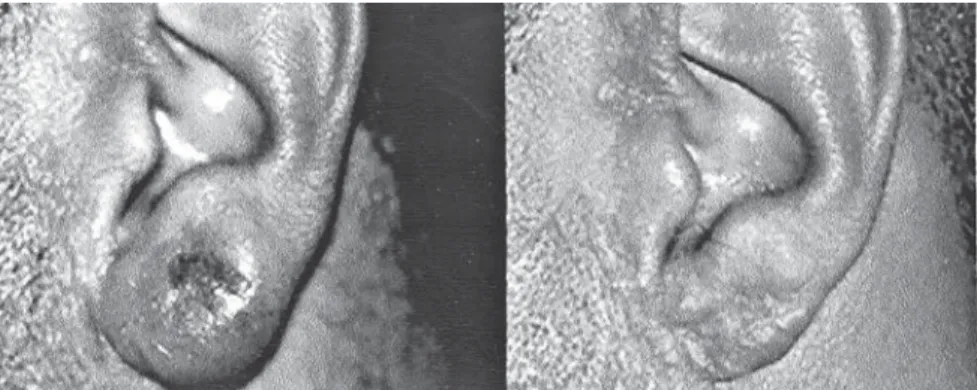376
Revista da Sociedade Brasileira de Medicina Tropical 39(4):376-378, jul-ago, 2006
RELATO DE CASO/CASE REPORT
Successful therapeutic response of resistant cases of
mucocutaneous leishmaniasis to a very low dose of antimony
Resposta terapêutica bem sucedida de casos resistentes de leishmaniose
mucocutânea a doses muito baixas de antimônio
Manoel Paes de Oliveira-Neto
1and Marise da Silva Mattos
1ABSTRACT
Two mucocutaneous leishmaniasis cases resistant to therapy are reported here. After the failure of initial therapies (antimony, amphotericin B and/or pentamidine) patients received a low-dose schedule: one ampoule of meglumine antimoniate (405mg of pentavalent antimony [Sbv]) by intramuscular injection, three times a week until complete healing of the lesions. One
patient was cured with a total of 30 ampoules in 10 weeks and the other received 36 ampoules in 12 weeks. Both remain clinically cured after one year of follow-up.
Key-words: Mucocutaneous leishmaniasis. Therapy-resistance. Antimony. Low dose.
RESUMO
São relatados dois casos de leishmaniose mucocutânea resistentes ao tratamento. Depois das terapêuticas iniciais (antimônio, anfotericina B e/ou pentamidina), os pacientes receberam um esquema alternativo: uma ampola de antimoniato de meglumina (405mg de antimônio pentavalnte [Sbv]) por via intramuscular, três vezes por semana até a cura completa das lesões. Um
paciente recebeu um total de 30 ampolas durante 10 semanas e o outro, 36 ampolas durante 12 semanas. Ambos permanecem clinicamente curados até um ano após o tratamento.
Palavras-chaves: Leishmaniose mucocutânea. Resistência a terapêutica. Antimônio. Baixa dose.
1. Ambulatório de Leishmaniose do Instituto de Pesquisas Clínicas Evandro Chagas da Fundação Oswaldo Cruz, Rio de Janeiro, RJ. Address to:Dra. Marise da Silva Mattos. Rodovia Haroldo Soares Glavan 929, Casa 2, Cacupé, 88050-005 Florianópolis, SC. Tel: 55 48 3338-3772; Fax: 55 48 3234-4748
e-mail: m.s.mattos@ipec.fiocruz.br Recebido para publicação em 27/6/2005 Aceito em 15/5/2006
The standard regimen of pentavalent antimony (Sbv)
recommended by the World Health Organization for mucocutaneous leishmaniasis is 20mg/kg/day parenterally applied for 3 to 4 weeks. An advantage of this regimen is its established use. Its disadvantages, however, are numerous and include cost, the requirement of daily injections and the considerable morbidity of antimony therapy. In Rio de Janeiro
State,Leishmania(Viannia)braziliensis (L. (V.) braziliensis)
is the only species detected so far7. Other drugs commonly
used for the treatment are amphotericin B and pentamidine, but the former is considerably toxic and the latter seems to
be less effective in controlling L. (V.) braziliensis infections1.
The parenteral use of high doses of antimony for long periods of time has been shown to be highly effective for the treatment
of cutaneous leishmaniasis2 8. A modality not previously
explored, is a regimen using a low dose of antimony
administered over long periods, more precisely until clinical cure. Our experience in Rio de Janeiro showed that
Leishmania infection may be controlled with low doses of antimony. Even minimal doses applied in intralesional therapy
were effective in many cases11. Based on the observations
377 Oliveira-Neto and Mattos MS
CASE REPORTS
Case1. Male, aged 31. This patient presented a cutaneous lesion on the left malar region extending to the tragus and left ear lobe. Histopathology was positive for amastigotes. The first treatment, in September 1999, consisted of a dose of 14mg of antimony per kilogram of body weight, by intramuscular injection, for 20 days. The lesion was still active one month after the end of therapy. A new treatment with a dose of 5mg of antimony/kg/day was applied for 30 days, but three months later the lesion was active once more. Then the patient was treated with amphotericin B, but since he presented renal insufficiency at the cumulative dose of 300mg, the treatment had to be discontinued. After an interval of ten months, pentamidine was used with a total dose of 1,500mg until lesion healing; even so reactivation occurred a few months later. The schedule of one ampoule three times a
week, on Mondays, Wednesdays and Fridays, was then applied for 10 weeks, totaling 30 ampoules, and at that time the lesion was completely healed. No side effects were noted. The patient remains well up to one year and four months of follow-up after the end of this last treatment (Figure 1).
Case 2. male, aged 64. This patient, with type II diabetes mellitus, presented several cutaneous lesions. The in-print of one lesion was positive for amastigotes. He was treated initially with 10mg of antimony per kilogram of body weight for 30 days. All the lesions cleared, but one year after the end of therapy, the patient presented two vegetant lesions on the penis glands and prepuce, initially diagnosed as a venereal disease. However, the histopathology showed amastigotes. He was then treated with the same long-term schedule used in Case 1 and after a 12 week period, totaling 36 ampoules, the lesion was healed. No side effects were noted. The patient remains well up to 9 months after the end of therapy (Figure 2).
Figure 1 - Aspect of the lesion before (left) and after (right) long-term therapy.
378
Revista da Sociedade Brasileira de Medicina Tropical 39(4):376-378, jul-ago, 2006
DISCUSSION
Although used for more then 50 years and considered, even
now, as the first-choice drug for the treatment of leishmaniasis4,
antimony is far from ideal. Several papers have been published during this time searching for a more suitable schedule of antimony therapy that is either less toxic and/or easier to
apply5 11 12 14 17. In Rio de Janeiro State, an endemic area of
Leishmania (V.) braziliensis transmission as the sole agent for
tegumentary leishmaniasis7, the efficacy of low doses of
antimony have been regularly demonstrated10 15, even in the
treatment of mucosal lesions13. The majority of proposed
antimony schedules are based on the antimony dose, not on the treatment period. In a few cases, prolonged treatment
period with high doses has been tested2 8. The application of
